Created by Diep Anh at 2024-03-06 14:35:28
,
Updated by Nhung Pham at 2025-12-30 15:46:57
Southeast Asia is renowned for its vibrant cultures, stunning landscapes, and delicious cuisine. Each country has its unique food culture, influenced by its history, geography, and religion. Let’s explore the food culture of four countries: Vietnam, Laos, Thailand, and Cambodia in this blog.
Food culture encompasses the entire spectrum of attitudes, beliefs, practices, and traditions surrounding the production, distribution, and consumption of food. It goes beyond simply the ingredients and recipes that make up a cuisine, delving into the deeper connections between food and the people who consume it.
Food culture in Vietnam
Vietnam, with its rich culinary heritage, boasts one of the most diverse and flavorful gastronomies in the world. Let’s delve into the fascinating food culture of Vietnam.

Food Culture in Vietnam
1. Rice-Based Culture
- Rice is the cornerstone of Vietnamese cuisine. It’s not just a staple; it’s a symbol of happiness and sustenance. In ancient Vietnamese characters, the word for “happiness” is depicted as many rice plants within a square, representing a paddy field.
- Vietnamese meals revolve around rice: boiled rice, rice porridge, steamed rice, glutinous rice cakes, and the iconic Banh Chung (square cake). Even the beloved Pho soup is made from rice noodles.
- Rice is the sun at the center of Vietnam’s culinary solar system, radiating nourishment and tradition.
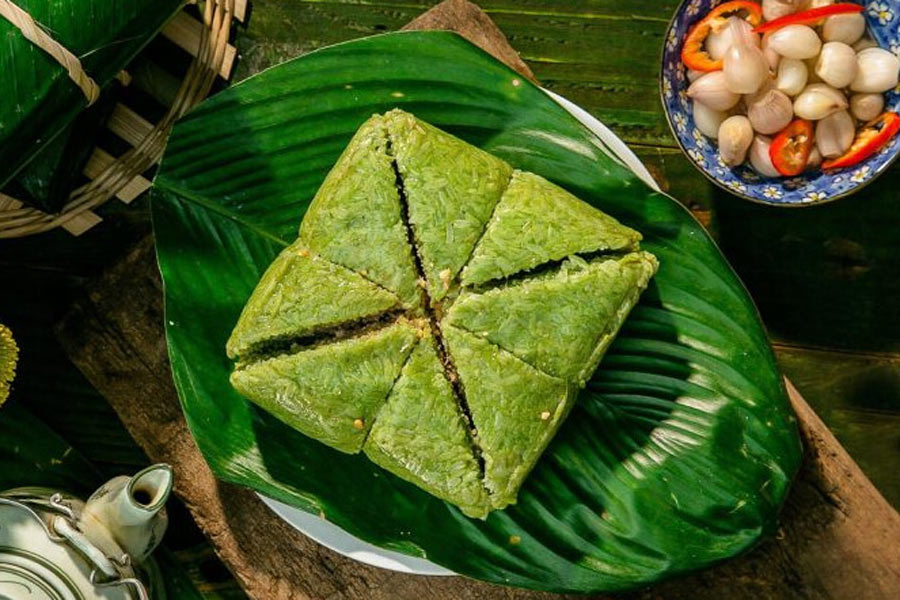
Banh chung

Pho
2. Fish Sauce
- Fish sauce (nuoc mam) is the umami elixir that infuses Vietnamese dishes with depth and complexity. It’s an essential condiment found in every Vietnamese meal.
- Made from fermented fish, salt, and water, fish sauce adds a savory punch to everything from dipping sauces to marinades.
3. Snack Paradise
- Vietnamese street food is a vibrant tapestry of flavors. From bustling markets to humble roadside stalls, you’ll find an array of snacks.
- Banh mi (Vietnamese baguette sandwiches), banh xeo (savory pancakes), and goi cuon (fresh spring rolls) are just a few delightful options.
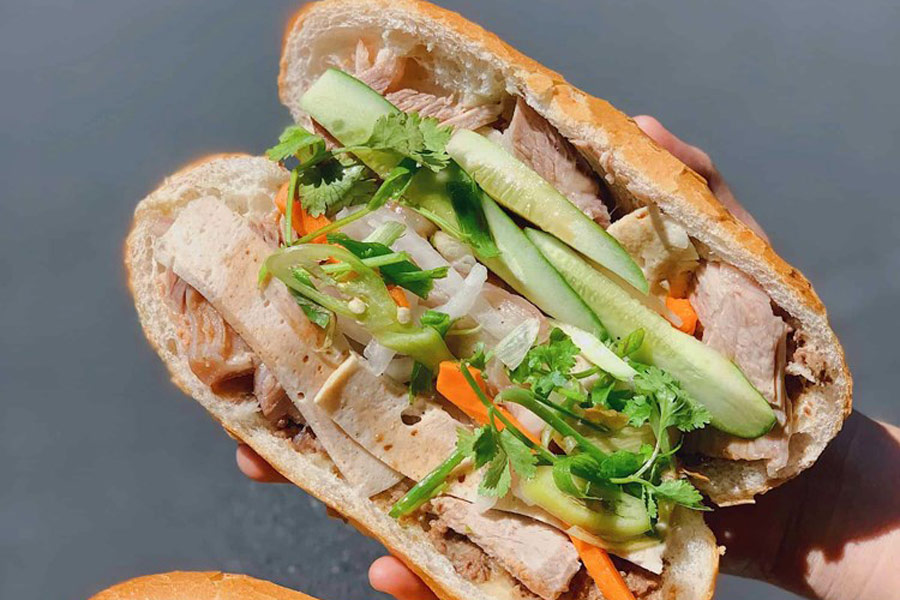
Banh mi

Banh xeo
4. Unity in Diversity
- Vietnam’s regional diversity shines through its cuisine. Each region has its specialties, influenced by geography, climate, and history.
- From the fiery dishes of the south to the delicate flavors of the north, Vietnamese food celebrates both unity and diversity.
In summary, Vietnamese food culture is a harmonious blend of tradition, innovation, and reverence for ingredients. Whether you’re savoring a bowl of pho or nibbling on crispy spring rolls, each bite tells a story of Vietnam’s rich culinary heritage
You may interested in: Top 10 unique Vietnamese dishes should not be overlooked
Food Culture in Laos
Laos, a land of lush landscapes and rich heritage, boasts a captivating food culture that reflects its history, geography, and social connections. Let’s delve into the delightful world of Laotian cuisine.
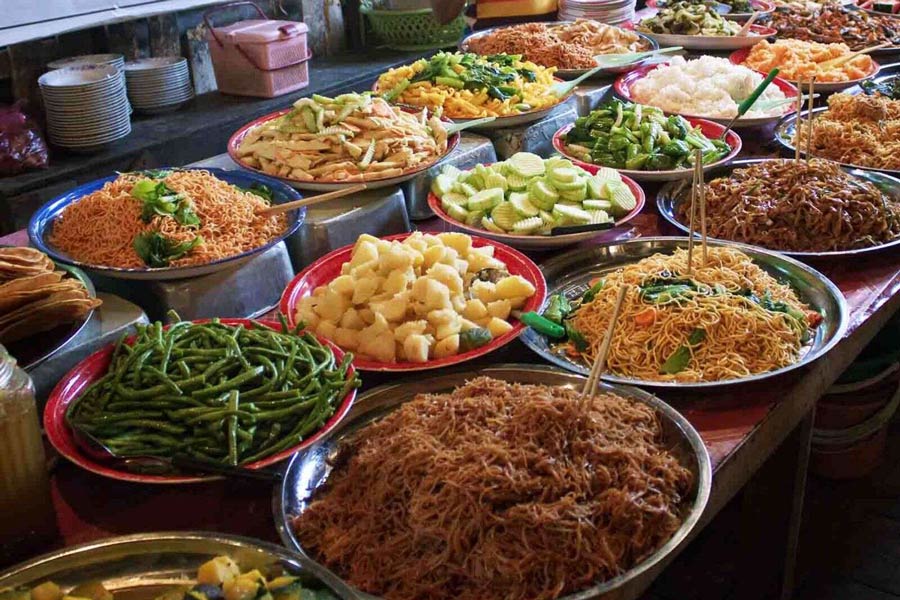
Food culture in Laos
1. Sticky Rice (Khao Niao)
- Sticky rice (khao niao) is the staple food of Laos. It’s not just a side dish; it’s a cultural icon.
- Days start early as sticky rice, soaked overnight, is cooked along with a range of dishes. Traditionally, the food is cooked over an open flame, fueled by a tree branch that gets pushed along as the end burns away.
2. Communal Dining
- In Laos, food is more than sustenance; it’s a means of connecting with others. Traditional Lao meals are often served family-style, with an emphasis on communal dining.
- Sharing dishes encourages conversation, fosters a sense of togetherness, and reinforces the importance of relationships within the culture
3. Local Markets
- To truly immerse oneself in Laos food culture, a trip to the local markets is a must. These bustling hubs of activity offer an array of fresh ingredients, from tropical fruits and vegetables to aromatic herbs and spices.
- Different markets operate at various times, but early mornings or late afternoons are the best times to visit.

Food culture in Laos
4. Flavor Symphony
- Laotian cuisine takes inspiration from Indian and Thai food, often combining sweet, salty, sour, and spicy tastes.
- Popular dishes include laap (minced meat salad), tam mak houng (green papaya salad), and the fiery kick of jeow mak keua (smoked and spicy eggplant dipping sauce).
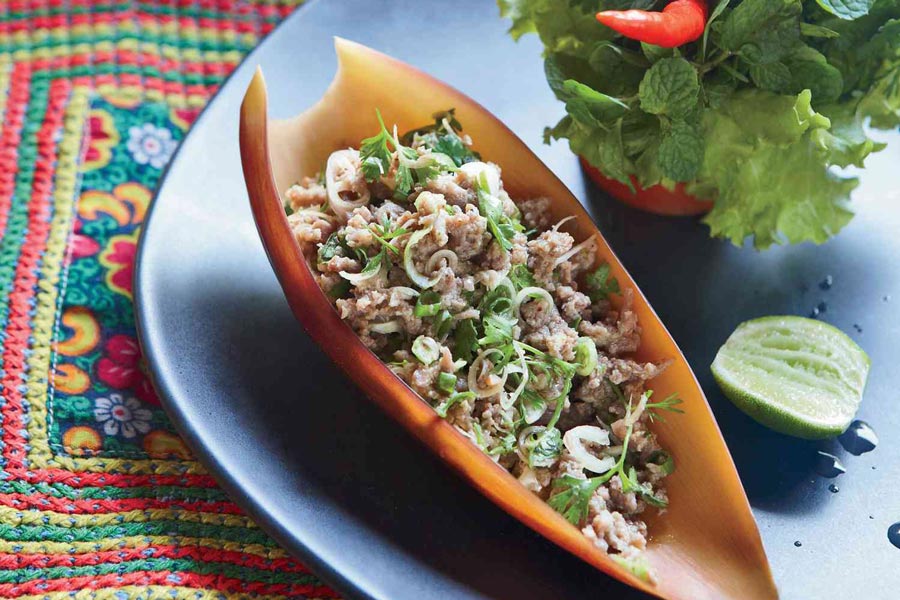
Laap
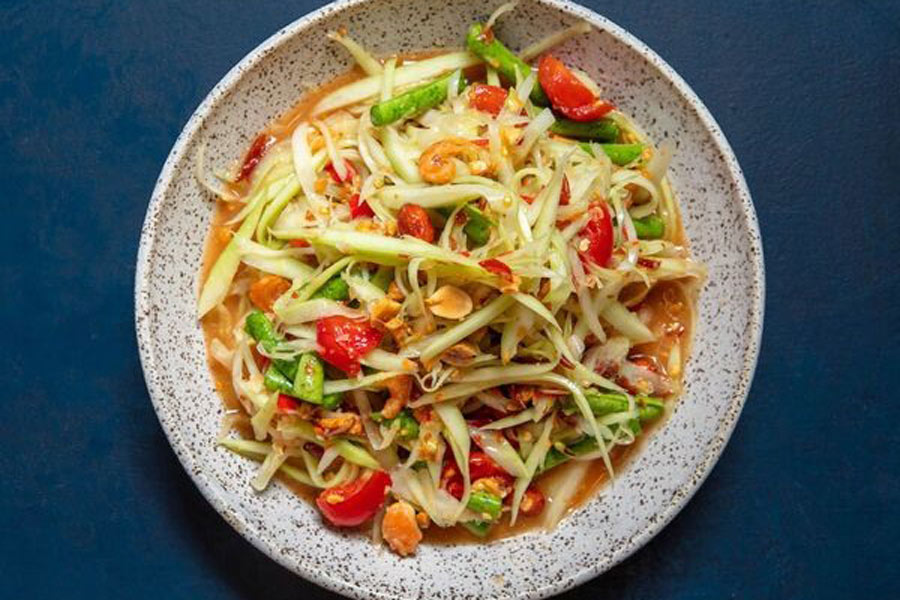
Tam Mak Houng
In summary, Laos food culture celebrates diversity, balance, and community. Whether enjoying a hearty meal of laap with friends or savoring the fiery kick of tam mak houng, each bite is a testament to the vibrant and enduring culture of Laos.
You may interested in: Must-try dishes when coming to Laos
Food Culture in Thailand
Thai food culture is a vibrant tapestry woven from centuries of history, diverse influences, and a deep appreciation for culinary artistry. Let’s explore the flavors, customs, and traditions that make Thai cuisine so captivating.
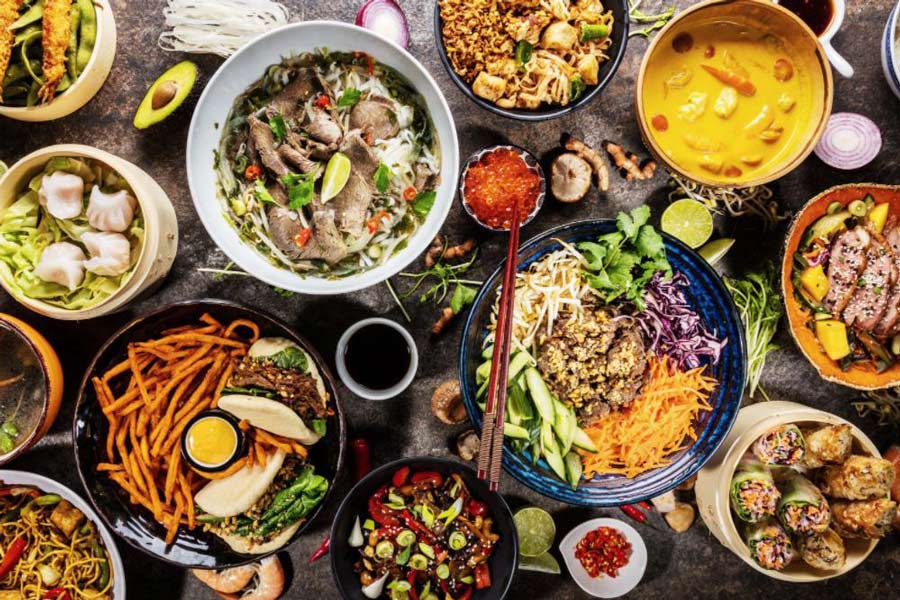
Food culture in Thailand
1. Key Flavors
A typical Thai meal dances on the palate with a symphony of five main flavors: salty, sweet, sour, bitter, and spicy. These elements harmonize to create a balanced and satisfying culinary experience. Whether it’s a fiery curry or a delicate salad, Thai dishes aim to incorporate all these dimensions.
2. Social Occasion
- In Thailand, food is more than sustenance; it’s a celebration. Social occasions often revolve around meals, where family and friends come together to share not only food but also stories, laughter, and connections.
- When dining out or preparing a meal at home, Thai diners enjoy a variety of dishes: meat or fish, vegetables, noodles, and perhaps soup. Everything is shared, fostering a sense of togetherness.

Food culture in Thailand
3. Influences
- Ancient Roots: As early as the 13th century, Thai cuisine began to take shape. It combined various meats, seafood, rice, local vegetables, and aromatic herbs. Pungent garlic and pepper added depth to the flavors.
- Chinese Influence: The Chinese introduced noodles and the essential Thai cooking tool—the steel wok.
- Indian Spices: Thai curries (green, red, and yellow) bear Indian influences. However, they maintain their unique flavors through local ingredients like Thai holy basil, lemongrass, and galangal.
- Neighboring Countries: Vietnam, Cambodia, Indonesia, Laos, Burma, and Malaysia have also contributed to the rich mosaic of Thai cooking.
4. Rice
Jasmine rice occupies a sacred place in Thai cuisine. It’s served with reverence and never wasted. Thailand cultivates various rice varieties, but Jasmine remains the most favored, albeit the most expensive.
5. Desserts
- Thai desserts range from simple fresh fruits (pineapple, guava, durian, and more) to elaborate treats like colorful rice cakes, coconut-coated rice dumplings, and grass jelly.
- Thai food culture is a delightful blend of tradition, innovation, and shared joy—a feast for the senses that continues to captivate food enthusiasts worldwide.
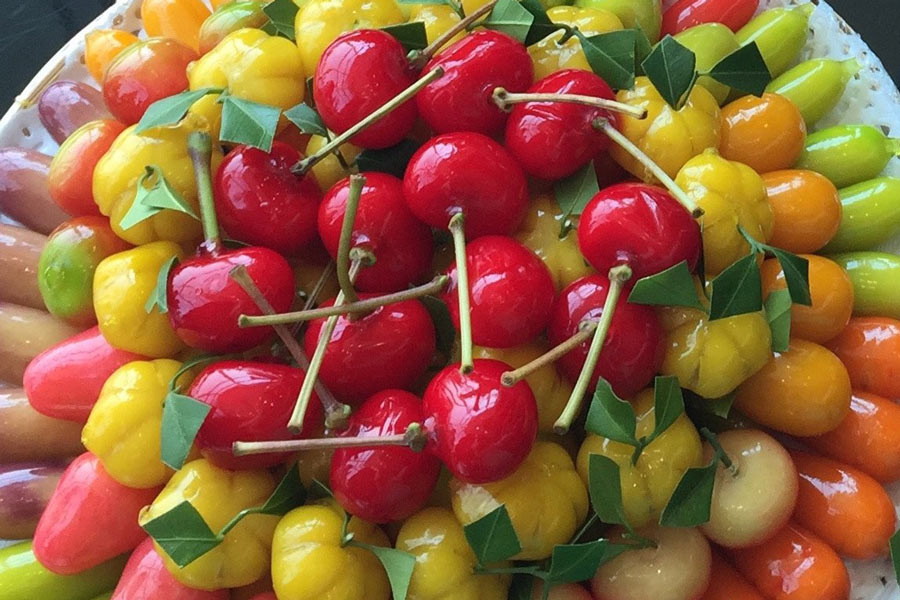
Colorful rice cakes
You may interested in: Top 10 must-try dishes from Thailand
Food culture in Cambodia
Cambodian food culture is a delightful fusion of tradition, local ingredients, and historical influences. Let’s explore the flavors and dishes that make Cambodia’s cuisine unique.
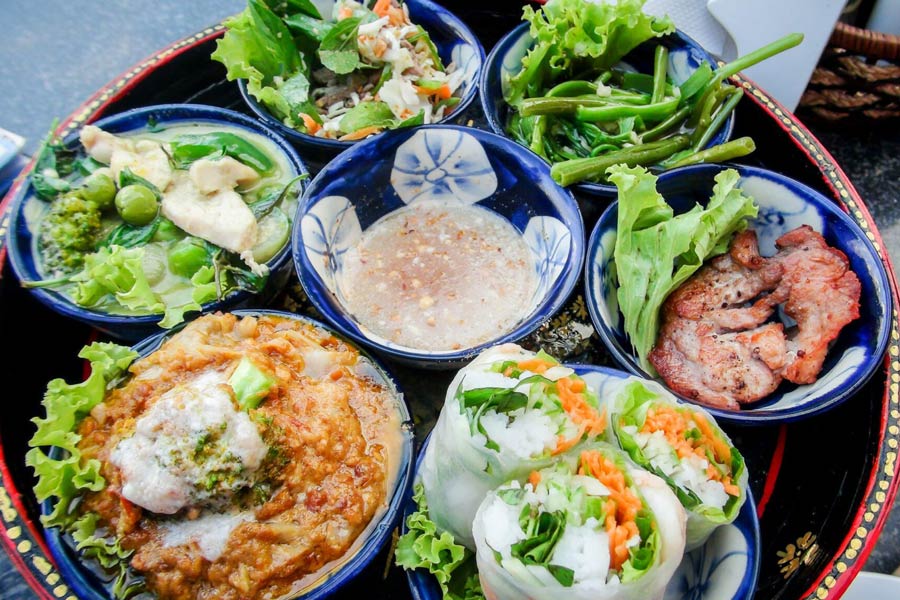
Food culture in Cambodia
1. Staple Ingredients
- Rice: Cambodia’s staple grain is rice. The Khmer term for “to eat” directly translates to “eat rice.” Regular aromatic rice and delicious glutinous sticky rice are common.
- Fish and Seafood: Freshwater fish and seafood, such as salmon, squid, and prawns, play a significant role in Cambodian cuisine. They feature prominently in soups, curries, stir-fries, and salads due to the country’s abundance of waterways.
- Greens and Herbs: Cambodians love their greens. Vegetables are served crisp and fresh or wok-fried in curries, soups, and stews. Basil, mint, coriander, and other herbs flavor and garnish the food.

Fish and seafood
2. Distinctive Flavors
- Cambodian food is akin to Thai cuisine but with a precise set of flavors: salty, sweet, spicy, and sour. These elements create a harmonious taste profile.
- Prahok: A fermented paste made from a small fish called trey riel, prahok is a hallmark of Khmer cuisine. It’s used both as a condiment and a main element in various dishes.
- Kroeung: This distinctive spice paste combines lemongrass, kaffir lime, and galangal. It adds depth and flavor to many Cambodian dishes.
3. Popular Dishes
- Amok (Coconut Fish Curry): Cambodia’s national dish, amok trey, is a fragrant and spicy coconut fish curry steamed in banana leaves. It has a mousse-like texture and is often made with chicken, tofu, or snails.
- Kuy Teav (Noodle Soup): A common breakfast dish, kuy teav features rice vermicelli, beef or pork bones, and a flavorful broth with fried shallots, green onion, and garlic.
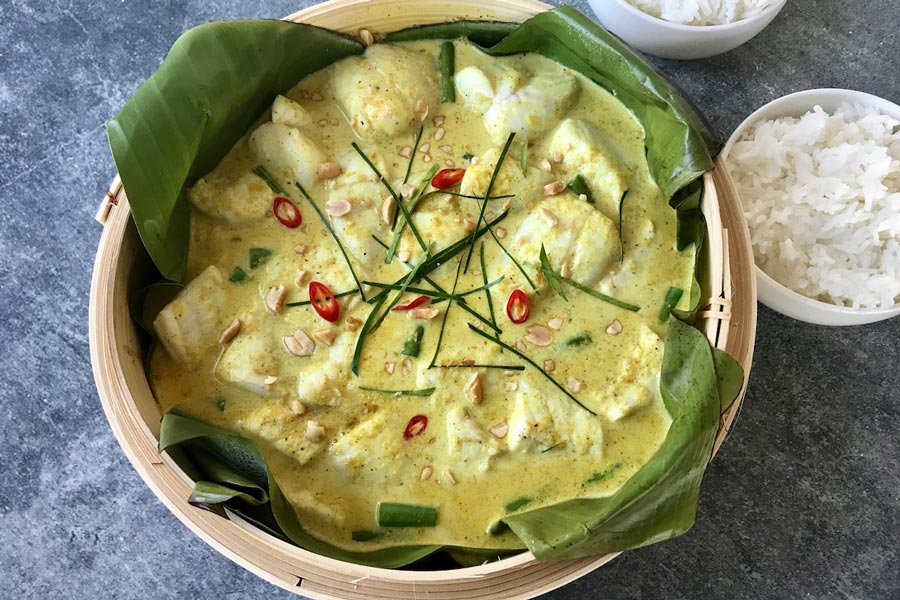
Amok
4. French Influence
Cambodia’s food culture has been shaped by its history, including French colonial influence. French-style baguettes, buns, and baked goods are part of the culinary landscape.
Cambodian food culture celebrates diversity, bold flavors, and the joy of sharing meals with loved ones. Whether you’re savoring amok or slurping kuy teav, each bite tells a story of this enchanting country
You may interested in: A Culinary Adventure of 7 Must-Try Delights
Conclusion
Southeast Asian cuisine is a tapestry of bold flavors, fresh ingredients, and unique cooking techniques. Each country in the region offers a distinct culinary experience that is sure to tantalize your taste buds.
Contact Asia King Travel to book your adventure today and explore the vibrant food cultures of Vietnam, Laos, Thailand, and Cambodia















